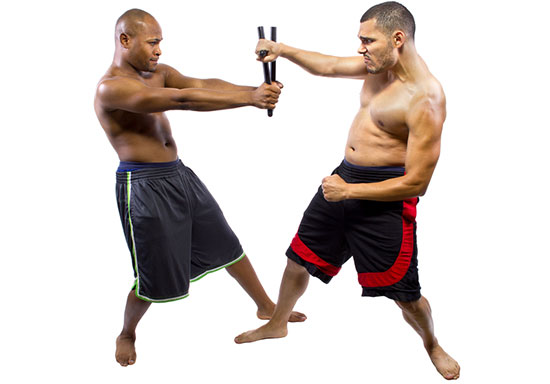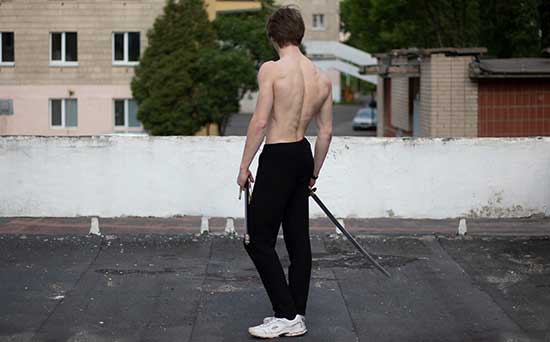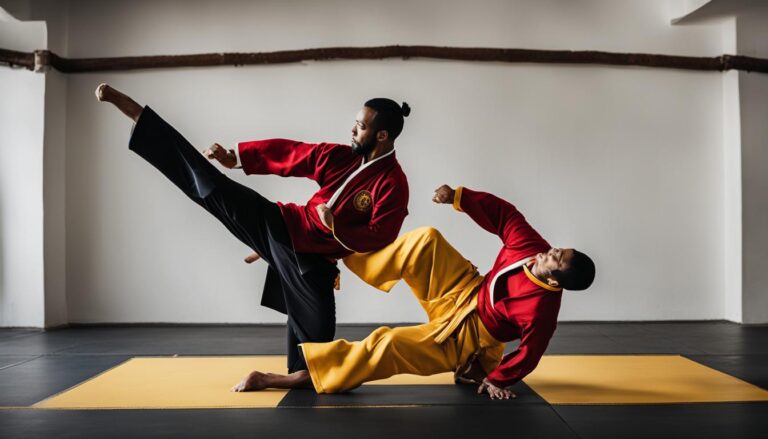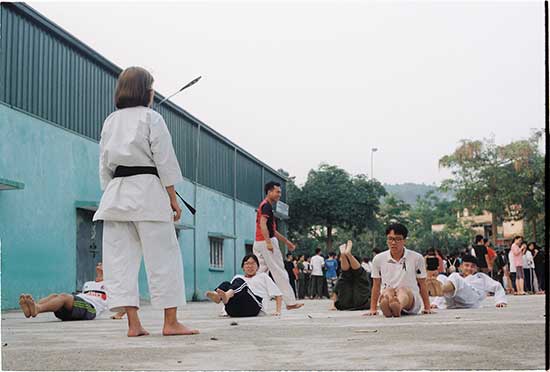Capoeira, a Brazilian martial art form that originated among African slaves in the 16th century, is often seen as a non-contact and non-functional martial art. However, many who have trained in various martial arts believe that Capoeira is actually the best option for self-defense.
It offers unique benefits, such as techniques that prioritize the safety of the practitioner’s hands, effective sweeps and takedowns, the development of peripheral vision and awareness, the inclusion of “dirty tricks” for real-world situations, and the ability to read people and avoid potential threats.
Key Takeaways:
- Capoeira is a Brazilian martial art that originated among African slaves in the 16th century.
- It offers unique benefits for self-defense, including techniques that prioritize hand safety.
- Capoeira incorporates effective sweeps and takedowns for subduing attackers.
- Practitioners develop peripheral vision and environmental awareness through Capoeira training.
- The art of “dirty tricks” in Capoeira prepares practitioners for real-life self-defense situations.
Contents
The Importance of Hand Safety in Self-Defense
Capoeira, a Brazilian martial art form that prioritizes the safety of its practitioners, offers unique benefits for self-defense, particularly when it comes to hand safety. Unlike traditional martial arts that rely heavily on punches and strikes with closed fists, Capoeira emphasizes kicks, sweeps, open-palmed strikes, and headbutts.
These techniques provide safer types of strikes that do not expose the practitioner’s hands to the same risk of injuries as traditional boxing or striking martial arts.
By prioritizing hand safety, Capoeira allows practitioners to effectively defend themselves in real-life situations without fear of injuring their hands. This is especially valuable considering that hand injuries can be common among fighters who rely heavily on punching.
The emphasis on open-palmed strikes and kicks in Capoeira not only reduces the risk of hand injuries but also enables practitioners to strike with precision and power, using a larger surface area to make contact with their opponents.
In addition to minimizing the risk of hand injuries, Capoeira’s focus on open-palmed strikes, kicks, and other techniques also allows practitioners to adapt to various scenarios. Whether defending against an unarmed assailant or an attacker wielding a weapon, Capoeira’s emphasis on hand safety ensures that practitioners can effectively defend themselves without compromising their ability to fight back.
The Importance of Hand Safety in Capoeira
| Traditional Martial Arts | Capoeira |
|---|---|
| Relies heavily on punches and strikes with closed fists | Emphasizes kicks, open palmed strikes, and headbutts |
| Higher risk of hand injuries | Minimizes the risk of hand injuries |
| Less adaptability in different scenarios | Allows practitioners to adapt to various situations |
Effective Sweeps and Takedowns for Self-defense
Capoeira’s effectiveness as a self-defense martial art lies in its incorporation of sweeps and takedowns from the Batuque fighting style.
These techniques offer practical applications for real-life situations, allowing practitioners to swiftly and forcefully take down opponents without getting entangled or dragged down with them. By utilizing the floor as a weapon, Capoeira practitioners can subdue attackers and gain control of the situation.
Unlike some traditional martial arts that focus primarily on strikes and punches, Capoeira’s emphasis on sweeps and takedowns provides a distinct advantage in self-defense training. These techniques are specifically designed to incapacitate an opponent quickly and efficiently, allowing practitioners to neutralize threats without unnecessary harm or risk.
The fluid movements and agility of Capoeira make it highly effective in real-world self-defense scenarios.
Below is a detailed table showcasing some of the most impactful sweeps and takedowns in Capoeira:
| Technique | Description |
|---|---|
| Martelo de Chão | A sweeping kick executed with a circular motion, targeting the opponent’s lower body to disrupt their balance and bring them to the ground. |
| Aú Batido | A spinning kick performed while in a handstand position, using the momentum to knock down an opponent. |
| Rasteira | A low sweeping kick aimed at the opponent’s legs to trip them or force them off balance. |
| Queda de Rins | A takedown technique involving a powerful knee strike to the opponent’s side, destabilizing them and allowing for a controlled takedown. |
| Benção | A sweeping kick delivered with precision and speed, targeting the opponent’s legs or torso, enabling a forceful takedown. |
These sweeps and takedowns, when executed with proper timing and technique, can quickly shift the dynamics of a self-defense situation. Capoeira’s emphasis on agility, flexibility, and strategic movements makes it a formidable fighting style for those seeking effective self-defense training.
Developing Peripheral Vision and Environmental Awareness
Capoeira training goes beyond just physical techniques for self-defense. It also focuses on developing peripheral vision and environmental awareness, which are crucial skills in real-life self-defense situations.
Unlike controlled environments like a boxing ring or octagon, actual self-defense scenarios often involve multiple attackers, dangerous obstacles, and innocent bystanders. Capoeira practitioners are trained to maintain focus on their opponent while remaining aware of their surroundings.
By participating in rodas, which are Capoeira circles where practitioners engage in playful combat, individuals learn to distinguish between those who are willing to play and those who may pose a threat.
This ability to read people becomes invaluable in identifying potential dangers and avoiding unnecessary confrontations. In chaotic situations, having the skill to assess danger and make informed decisions is crucial for personal safety.
Benefits of Developing Peripheral Vision and Awareness
- Improved situational awareness
- Ability to identify potential threats or dangers
- Enhanced decision-making skills in self-defense scenarios
- Better understanding of the surrounding environment
Overall, developing peripheral vision and environmental awareness through Capoeira training equips individuals with valuable tools to navigate real-world self-defense situations effectively.
Capoeira’s “Dirty Tricks” for Effective Self-Defense
Capoeira is not your typical martial art. It goes beyond the traditional punches and kicks, incorporating a unique set of techniques known as “dirty tricks” that are specifically designed for real-world self-defense situations. These deceptive moves, rooted in the art of “malicia,” give Capoeira practitioners an advantage when faced with unexpected confrontations.
One such dirty trick is the use of handshakes as an opportunity for surprise attacks. By concealing their intentions and then swiftly transitioning into a headbutt or strike, Capoeira practitioners can catch their adversaries off guard, gaining the upper hand in a confrontation.
Feints are another valuable tool in the Capoeira arsenal. By executing quick strikes like chapa, practitioners can create openings in their opponent’s defenses. This misdirection and unexpected strikes can disorient and confuse attackers, allowing the Capoeira practitioner to gain control of the situation.
| Dirty Trick | Description |
|---|---|
| Handshake Surprise | Using a handshake as an opportunity for a surprise headbutt or strike. |
| Feints and Misdirection | Executing quick strikes to create openings in the opponent’s defenses. |
| Eye Pokes | Using misdirection followed by eye pokes to disable attackers. |
Capoeira’s emphasis on “dirty tricks” prepares practitioners for real-life self-defense scenarios, where clean techniques may not be effective or practical. By training in these deceptive techniques, Capoeira practitioners develop the skills needed to defend themselves efficiently in unpredictable situations.
The Art of Reading People for Self-Defense
One of the most valuable skills that Capoeira offers for self-defense is the ability to read people. Through playing in rodas and participating in the dynamic interactions of the practice, practitioners develop a keen sense of discernment when it comes to assessing others’ intentions and potential threats.
This skill becomes particularly crucial in real-life self-defense situations, where the ability to evaluate danger and make informed decisions can mean the difference between safety and harm.
In Capoeira, practitioners learn to distinguish between those who are willing to play and enjoy the art form and those who may be looking for a fight or seeking to cause harm. The intricate movements and exchanges in the roda provide valuable insights into an individual’s body language, level of control, and overall demeanor.
By honing their observational skills, Capoeira practitioners are better equipped to assess the intentions and capabilities of others, allowing them to avoid unnecessary confrontations and potentially dangerous situations.
Additionally, Capoeira training instills a heightened sense of situational awareness. Through constant movement and engagement with various partners in the roda, practitioners learn to maintain a broad field of vision while remaining focused on their immediate opponent.
This skill of maintaining peripheral vision and environmental awareness is invaluable in chaotic self-defense scenarios, where multiple attackers, obstacles, and innocent bystanders may be present. By staying attuned to their surroundings, Capoeira practitioners can anticipate potential threats and effectively respond to them.
Overall, the art of reading people is an integral part of Capoeira’s training for self-defense. By developing the ability to discern others’ intentions, Capoeira practitioners gain an invaluable tool for personal protection.
Through their training in the roda, they learn to assess danger, avoid confrontations, and make informed decisions to keep themselves and others safe in real-life situations.
The Evolution of Capoeira and Its Relevance Today
Capoeira, the Brazilian martial art form, has undergone significant evolution throughout history, adapting to the changing societal landscape and the safety concerns of the modern era.
Originally practiced by African slaves in the 16th century as a means of self-defense, Capoeira has transformed into a more fluid and inclusive martial art. Today, it remains a relevant and effective option for self-defense in a society where real-world violence is less prevalent than in the past.
The evolution of Capoeira has been driven by the need to prioritize safety without compromising its effectiveness as a self-defense technique. In the early days, Capoeira was a hard fighting style practiced by individuals who needed to fight to survive.
Over time, it has incorporated elements such as acrobatics and dance-like movements, making it a unique martial art that combines strength, agility, and creativity.
Despite its transformation, Capoeira retains its self-defense efficacy. The techniques taught in Capoeira focus on practicality and effectiveness in real-world situations rather than adhering to the rules of a controlled environment.
Capoeira practitioners learn to use their entire body as a weapon, incorporating strikes, kicks, sweeps, and takedowns that can quickly subdue an attacker. By training in Capoeira, individuals develop the skills necessary to defend themselves confidently.
| Evolution of Capoeira | Relevance Today |
|---|---|
| Originally practiced by African slaves for self-defense | Capoeira remains a viable self-defense option |
| Incorporated dance-like movements and acrobatics | Combines strength, agility, and creativity |
| Focuses on practicality and effectiveness in real-world situations | Teaches techniques for subduing attackers |
Conclusion
Capoeira, a captivating Brazilian martial art, offers a range of benefits for self-defense. Its unique combination of dance, acrobatics, and martial arts techniques makes it a powerful and agile martial art form suitable for personal protection.
One of the key advantages of Capoeira is the emphasis on hand safety. Unlike traditional martial arts, where punches can lead to significant hand injuries, Capoeira prioritizes strikes that do not expose the practitioner’s hands to the same risk. This allows individuals to effectively defend themselves without fear of hurting their hands.
In addition, Capoeira’s effective sweeps and takedowns derived from the martial art form Batuque provide a valuable tool for subduing attackers and gaining control of a self-defense situation. By using the floor as a weapon, practitioners can swiftly and forcefully neutralize opponents without getting entangled.
Capoeira also cultivates peripheral vision and environmental awareness, essential skills for real-life self-defense scenarios. The training requires practitioners to remain focused on opponents while being aware of other players in the roda and potential threats in their surroundings. This heightened awareness equips individuals to navigate chaotic situations effectively.
Lastly, Capoeira teaches the art of “dirty tricks” or “malicia,” preparing practitioners for real-world self-defense situations. Techniques such as surprise headbutts and misdirection followed by eye pokes enable individuals to employ unconventional tactics when clean techniques may not be effective or practical.
Overall, Capoeira’s self-defense benefits, combined with its rich Brazilian heritage, make it a compelling choice for those seeking a dynamic and effective martial art form that goes beyond conventional methods.





